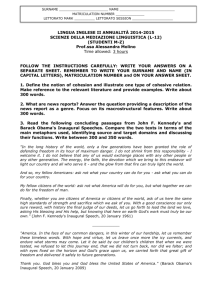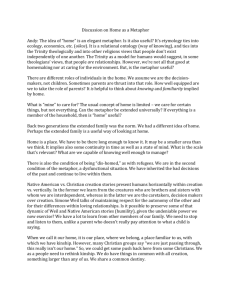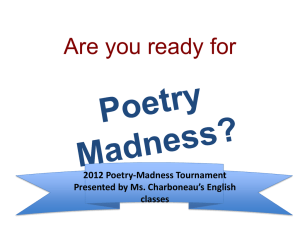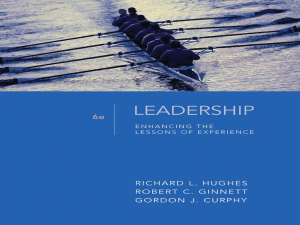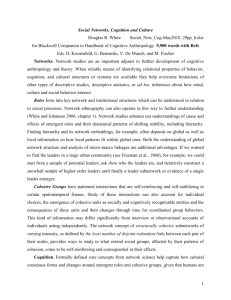SURNAME NAME MATRICULATION NUMBER LETTORATO MARK
advertisement
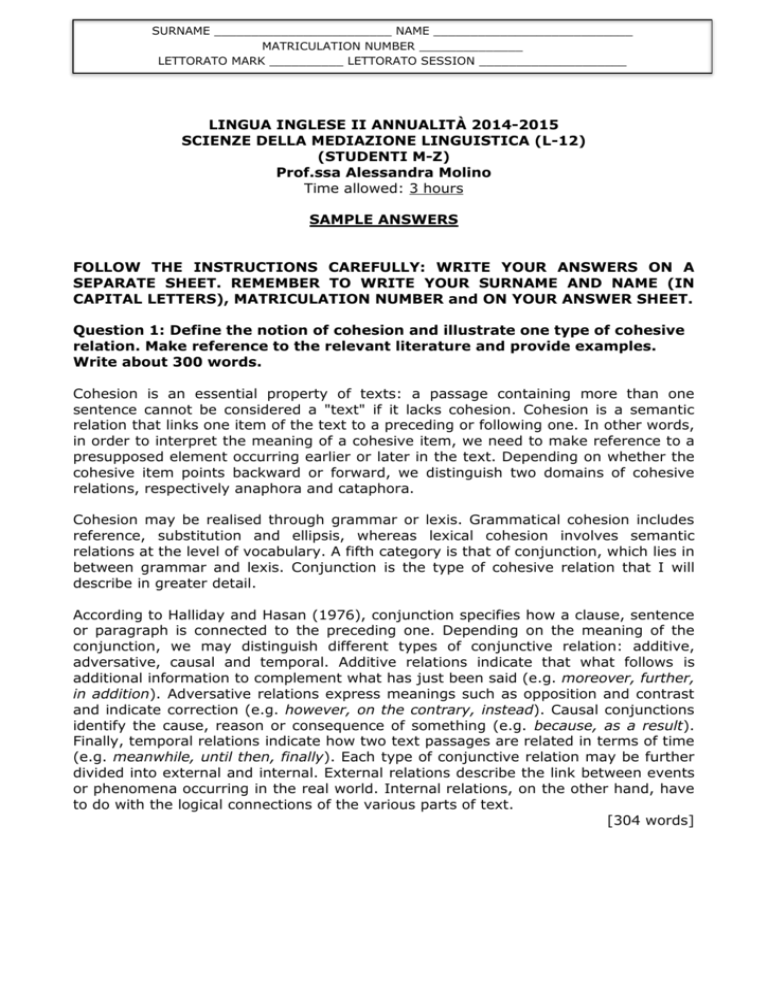
SURNAME ________________________ NAME ___________________________ MATRICULATION NUMBER ______________ LETTORATO MARK __________ LETTORATO SESSION ____________________ LINGUA INGLESE II ANNUALITÀ 2014-2015 SCIENZE DELLA MEDIAZIONE LINGUISTICA (L-12) (STUDENTI M-Z) Prof.ssa Alessandra Molino Time allowed: 3 hours SAMPLE ANSWERS FOLLOW THE INSTRUCTIONS CAREFULLY: WRITE YOUR ANSWERS ON A SEPARATE SHEET. REMEMBER TO WRITE YOUR SURNAME AND NAME (IN CAPITAL LETTERS), MATRICULATION NUMBER and ON YOUR ANSWER SHEET. Question 1: Define the notion of cohesion and illustrate one type of cohesive relation. Make reference to the relevant literature and provide examples. Write about 300 words. Cohesion is an essential property of texts: a passage containing more than one sentence cannot be considered a "text" if it lacks cohesion. Cohesion is a semantic relation that links one item of the text to a preceding or following one. In other words, in order to interpret the meaning of a cohesive item, we need to make reference to a presupposed element occurring earlier or later in the text. Depending on whether the cohesive item points backward or forward, we distinguish two domains of cohesive relations, respectively anaphora and cataphora. Cohesion may be realised through grammar or lexis. Grammatical cohesion includes reference, substitution and ellipsis, whereas lexical cohesion involves semantic relations at the level of vocabulary. A fifth category is that of conjunction, which lies in between grammar and lexis. Conjunction is the type of cohesive relation that I will describe in greater detail. According to Halliday and Hasan (1976), conjunction specifies how a clause, sentence or paragraph is connected to the preceding one. Depending on the meaning of the conjunction, we may distinguish different types of conjunctive relation: additive, adversative, causal and temporal. Additive relations indicate that what follows is additional information to complement what has just been said (e.g. moreover, further, in addition). Adversative relations express meanings such as opposition and contrast and indicate correction (e.g. however, on the contrary, instead). Causal conjunctions identify the cause, reason or consequence of something (e.g. because, as a result). Finally, temporal relations indicate how two text passages are related in terms of time (e.g. meanwhile, until then, finally). Each type of conjunctive relation may be further divided into external and internal. External relations describe the link between events or phenomena occurring in the real world. Internal relations, on the other hand, have to do with the logical connections of the various parts of text. [304 words] SURNAME ________________________ NAME ___________________________ MATRICULATION NUMBER ______________ LETTORATO MARK __________ LETTORATO SESSION ____________________ Question 2: What are news reports? Answer the question providing a description of the news report as a genre. Focus on its macrostructural features (write about 300 words) The news report is one of the genres of journalism. In various journalistic traditions, such as the British one, it is characterised by objectivity and factuality, and tends to avoid the explicit expression of opinion and the engagement of the reader. The news report is characterised by a typical macrostructure consisting of headline, attribution, lead and main body of the text. Headlines may be composed of a headline proper and a subheadline. The purposes of headlines are to attract the attention of readers, to present the main topic of the news report and to provide the perspective from which the story is told. To achieve these aims, headlines are characterised by rhetorical features such as alliteration, rhyme and assonance; they may contain emotive and evaluative language; and they tend to introduce the topic in a concise way through abbreviations, elliptical forms, and preferring lexical to function words. The attribution consists in the indication of the time and place of publication and the name of the journalist(s) who wrote the piece. The lead is the first paragraph of the news report. It is a strategic passage of the article as it offers a summary of the story following the so-called five Ws of journalism, i.e. who, when, where, what and why. In some newspapers the lead is printed in bold type to distinguish it from the rest of the text and in online editions it often corresponds to the short text that appears in the homepage. The last but largest portion of a news report is the body of the text, which presents the events in the narrative mode. Stories are normally not reported in chronological order; indeed an important distinction is that between "story" and "plot": the story corresponds to the sequence of events as they actually occurred, whereas the plot is the order in which they are reported. [309 words] SURNAME ________________________ NAME ___________________________ MATRICULATION NUMBER ______________ LETTORATO MARK __________ LETTORATO SESSION ____________________ 3. Read the following concluding passages from John F. Kennedy's and Barack Obama's Inaugural Speeches. Compare the two texts in terms of the main metaphors used, identifying source and target domains and discussing their functions. Write between 300 and 350 words. These two inaugural speeches were delivered in different historical and political phases. When Kennedy became President in 1961, the world's geopolitical landscape was changing, and the USA and the Soviet Union were competing for global supremacy. On the other hand, in 2009 Obama's main threats were the financial crisis and terrorism. Despite these differences, the concluding passages present remarkable similarities, among which the use of metaphor as a means of persuasion. In Kennedy's inaugural address, the items light, glow and fire remind the listeners of a recurrent metaphor in the tradition of American political rhetoric: that of the beacon. Even though the word beacon is not used, the concepts of FIRE and LIGHT inevitably activate the ideas connected to this metaphor: fire is a purifying element that stimulates passion and desire, whereas light is linked to knowledge, hope, vision and divine. LIGHT and FIRE are the source domains from which Kennedy draws to talk about political and civic engagement (the target domains) as forces that will guide the USA and the rest of the world to the achievement of the goals of defending and securing freedom. The beacon metaphor is not present in Obama's concluding passage, very likely because of America's inability to set itself as an example to the world in the midst of the financial crisis. Indeed, the metaphor employed by Obama to talk about the current adverse economic situation (target domain) is that of bad weather conditions (source domain) (e.g. winter; icy current; storms). This metaphor is effective because it enables him to refer to present difficulties in impersonal terms: the whether is generally taken to be a fact, which removes any possibility of blame or recrimination. This choice is in line the rhetorical purpose of inaugural speeches to overcome feelings of division. The third main metaphor is that of resolute social and political activity as a journey. This metaphor is present in both extracts (e.g. go forth in Kennedy's speech and journey, horizon, turn back in Obama's address) and serves to arouse enthusiasm from the social effort implied by a journey in the company of others having the same destination. [354 words]
